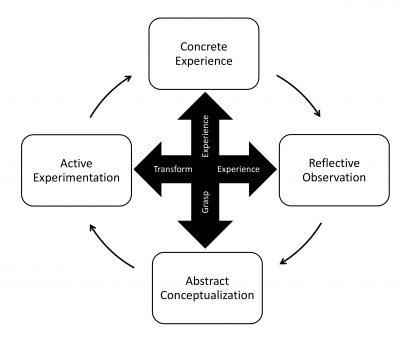“The process of learning from experience is ubiquitous, present in human activity everywhere all the time.” (Kolb & Kolb, 2017, p. 11)
The Experiential Learning Cycle
According to Kolb’s model of experiential learning, effective learning occurs in four stages (Fig. 1): concrete observation, reflective observation, abstract conceptualization, and active experimentation.
It is possible for the learner to enter at any of these four stages and follow them through their sequence to acquire new knowledge. For effective learning to occur, the learner should complete all four stages of the model and no one stage can stand alone as a learning procedure.

The Experiential Learning Cycle (Kolb & Kolb, 2017)
Benefits of Experiential Learning
♦ Makes learning relatable. Students build on and make connections between new and existing knowledge and skills.
♦ Increases the effectiveness of learning. Students engage in critical thinking, acquire problem solving skills, and engage in decision making.
♦ Links theory to practice. Students put theory into practice and make generalizations they can apply to future experiences.
♦ Develops skills for lifelong learning. Students develop essential transferable skills through reflection, conceptualization, and planning for next steps.
♦ Assists in memory retention. Students learn more deeply through both feeling and thinking.
♦ Increases students’ engagement. Students collaborate and support each other’s learning.
♦ Caters to various learning styles. All students have the opportunity to succeed in an inclusive classroom.
See Ryerson University’s summary of key scholarly findings about experiential learning.
Learn More
Journals